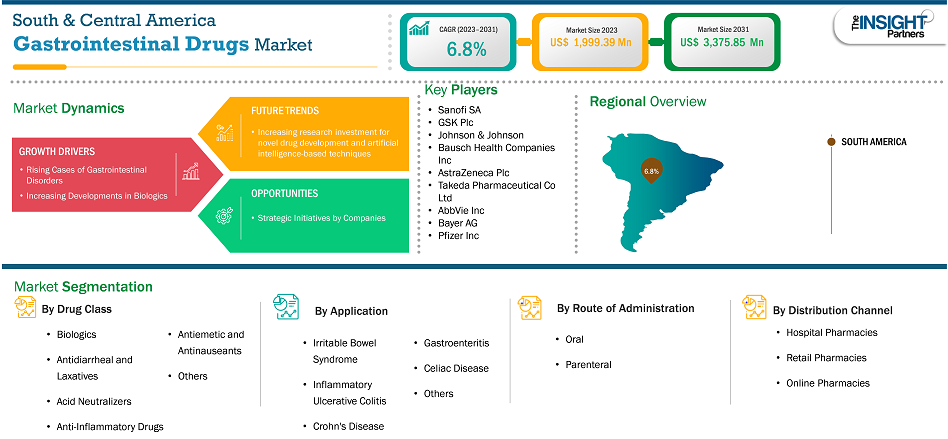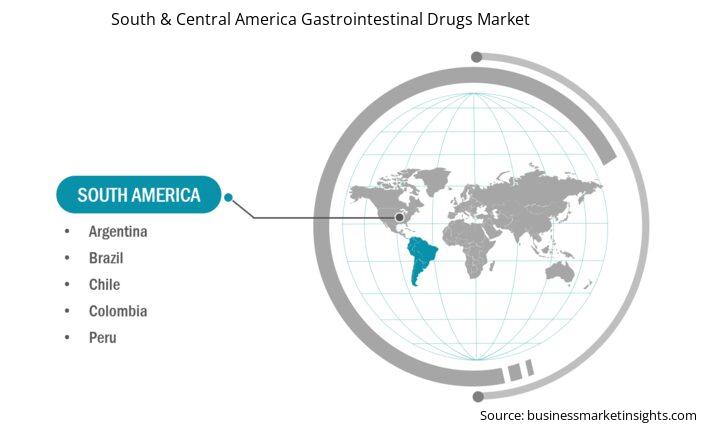South & Central America Gastrointestinal Drugs Market Report (2021-2031) by Scope, Segmentation, Dynamics, and Competitive Analysis
No. of Pages: 149 | Report Code: TIPRE00016303 | Category: Life Sciences
No. of Pages: 149 | Report Code: TIPRE00016303 | Category: Life Sciences
The South & Central America gastrointestinal drugs market size is expected to reach US$ 3,375.85 million by 2031 from US$ 1,999.39 million in 2023. The market is estimated to record a CAGR of 6.8% from 2023 to 2031.
South & Central America include Argentina, Brazil, and the Rest of South & Central America. The growing geriatric population in both countries is the prime factor for the growth of the market. Other factors, such as developments in the healthcare industry and growing research and development in the pharmaceutical sector, are likely to foster the market’s growth during the forecast period.

Key segments that contributed to the derivation of the gastrointestinal drugs market analysis are drug class, application, route of administration, and distribution channel.
Gastrointestinal diseases are conditions that occur in the gastrointestinal tract. Common digestive problems include heartburn, inflammatory bowel diseases (IBD), inflammatory bowel syndrome (IBS), gastroenteritis, gastroesophageal reflux disease (GERD), constipation, diarrhea, etc. Gastrointestinal diseases are common chronic inflammatory conditions that affect an enormous population worldwide. This is due to a sedentary lifestyle, changing dietary habits, and stress, among other factors. Also, the incidence and prevalence of gastrointestinal diseases are higher in adults, and as the population ages, the disease burden is also expected to increase.
According to the study, “Gastroesophageal Reflux Disease,” published in July 2023, GERD is one of the most prevalent diagnosed gastrointestinal conditions, affecting 20% of the people, resulting in major economic burden in direct and indirect costs and adversely impacting the quality of life.
Furthermore, the incidence and prevalence of IBS have increased in the last few decades globally. As per the International Foundation for Gastrointestinal Disorders, Inc., IBS is the most prevalent functional gastrointestinal disease, with a prevalence rate of 10–15% of the population across the globe. A study conducted by the University of Gothenburg states that for every ten adults in the world, four suffer from functional gastrointestinal disorders of varying severity. Thus, the rising prevalence of gastrointestinal diseases worldwide fuels the demand for treatment of these conditions, thereby driving the gastrointestinal drugs market.
Based on country, the South & Central America gastrointestinal drugs market comprises Brazil, Argentina, and the Rest of South & Central America. Brazil held the largest share in 2023.
Urbanization in Brazil has taken place at an alarming rate, particularly concerning food consumption. High consumption of sugar-based drinks, coffee, or processed foods and lack of sufficient intake of fiber contribute to issues affecting the digestive tracts of many people in Brazil, leading to various digestive disorders such as irritable bowel syndrome (IBS) and constipation.
In Brazil, the aging population is rapidly growing. According to the Pan American Health Organization in 2022, Brazil has more than 30 million older adults aged 60 years and above, representing 13% of the country’s population. By 2030, this age group will reach nearly 50 million, which will be 24% of the total population in Brazil. As per the Brazil Statistical Institute, the country’s population aged 65 and above is expected to account for 36% share of the total population by 2050. In South & Central America , Brazil is among the 10 countries with the largest population of older adults who frequently require services of the public health system.
The Inflammatory Bowel Disease (IBD) National Patient Registry is an initiative of the Brazilian Organization for Crohn's Disease and Colitis (GEDIIB) with the objective of surveying the epidemiological profile of patients suffering from IBD in the country by making a centralized registry with data on patients monitored in public and private healthcare services. According to the article titled “Clinical factors associated with severity in patients with inflammatory bowel disease in Brazil based on 2-year national registry data from GEDIIB,” published in February 2024, IBD has reached a prevalence of over 60 cases per 100,000 inhabitants in Brazil, depending on the degree of urbanization in the country. In São Paulo and Espírito Santo states, IBD prevalence rates were 52.6/100,000 and 38.2/100,000, respectively. Thus, due to the aging population, there is an increase in the incidence of gastrointestinal disorders, which fuels the market growth.
| Report Attribute | Details |
|---|---|
| Market size in 2023 | US$ 1,999.39 Million |
| Market Size by 2031 | US$ 3,375.85 Million |
| CAGR (2023 - 2031) | 6.8% |
| Historical Data | 2021-2022 |
| Forecast period | 2024-2031 |
| Segments Covered |
By Drug Class
|
| Regions and Countries Covered | South and Central America
|
| Market leaders and key company profiles |
|
Some of the key players operating in the gastrointestinal drugs market include Sanofi SA, GSK Plc, Johnson & Johnson, Bausch Health Companies Inc, AstraZeneca Plc, Takeda Pharmaceutical Co Ltd, AbbVie Inc, Bayer AG, and Pfizer Inc among others. These players are adopting various strategies such as expansion, product innovation, and mergers and acquisitions to provide innovative products to their consumers and increase their market share.
The following methodology has been followed for the collection and analysis of data presented in this report:
The research process begins with comprehensive secondary research, utilizing both internal and external sources to gather qualitative and quantitative data for each market. Commonly referenced secondary research sources include, but are not limited to:
Note: All financial data included in the Company Profiles section has been standardized to USD. For companies reporting in other currencies, figures have been converted to USD using the relevant exchange rates for the corresponding year.
The Insight Partners’ conducts a significant number of primary interviews each year with industry stakeholders and experts to validate its data analysis, and gain valuable insights. These research interviews are designed to:
Primary research is conducted via email interactions and telephone interviews, encompassing various markets, categories, segments, and sub-segments across different regions. Participants typically include:

The South & Central America Gastrointestinal Drugs Market is valued at US$ 1,999.39 Million in 2023, it is projected to reach US$ 3,375.85 Million by 2031.
As per our report South & Central America Gastrointestinal Drugs Market, the market size is valued at US$ 1,999.39 Million in 2023, projecting it to reach US$ 3,375.85 Million by 2031. This translates to a CAGR of approximately 6.8% during the forecast period.
The South & Central America Gastrointestinal Drugs Market report typically cover these key segments-
The historic period, base year, and forecast period can vary slightly depending on the specific market research report. However, for the South & Central America Gastrointestinal Drugs Market report:
The South & Central America Gastrointestinal Drugs Market is populated by several key players, each contributing to its growth and innovation. Some of the major players include:
The South & Central America Gastrointestinal Drugs Market report is valuable for diverse stakeholders, including:
Essentially, anyone involved in or considering involvement in the South & Central America Gastrointestinal Drugs Market value chain can benefit from the information contained in a comprehensive market report.